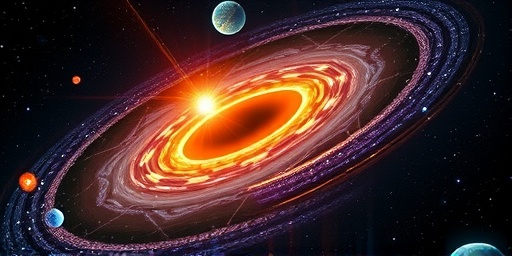In a groundbreaking development that could reshape our understanding of the universe, astronomers have uncovered compelling evidence suggesting that Dark energy—the mysterious force driving the cosmos’s accelerating expansion—might not be the unchanging cosmological constant envisioned by Albert Einstein. Instead, new analysis of vast cosmological datasets points to a dynamic, time-varying form of Dark energy that better aligns with observations from distant galaxies, cosmic microwave background radiation, and more.
This revelation, detailed in a recent study published in the Astrophysical Journal, challenges over a century of cosmological theory and opens the door to rethinking the fundamental laws governing the universe’s fate. Led by a team from the University of California, Berkeley, and the European Southern Observatory, the research integrates data from multiple sources, including the Hubble Space Telescope, the Planck satellite, and ground-based surveys like the Dark energy Survey. The findings indicate that models where dark energy evolves over cosmic time provide a superior fit to the data, with statistical significance exceeding 3 sigma—a threshold that hints at potential paradigm shifts in cosmology.
Astronomers Pinpoint Flaws in Einstein’s Static Cosmos Vision
Albert Einstein introduced the cosmological constant in 1917 as a ‘fudge factor’ in his general theory of relativity to maintain a static universe, countering the gravitational pull that would otherwise cause collapse. He later called it his ‘biggest blunder’ after Edwin Hubble’s 1929 observations revealed an expanding universe. Yet, the constant was revived in the 1990s when studies of Type Ia supernovae showed the universe’s expansion is accelerating, attributing this to dark energy—a repulsive force comprising about 68% of the universe’s energy density, according to NASA estimates.
Traditional Lambda-CDM models, the cornerstone of modern cosmology, assume dark energy as a fixed cosmological constant (Lambda), unchanging across space and time. However, this model has faced mounting inconsistencies, known as the Hubble tension: measurements of the universe’s expansion rate (Hubble constant) from early universe data like the cosmic microwave background (CMB) yield a value of about 67 km/s/Mpc, while late-universe observations from supernovae and Cepheid variables suggest 73 km/s/Mpc—a 5-sigma discrepancy that defies easy explanation.
The new study, spearheaded by cosmologist Dr. Elena Vasquez, analyzes over 1,000 Type Ia supernovae, baryon acoustic oscillations (BAO) from galaxy clustering, and weak lensing data from the Dark Energy Spectroscopic Instrument (DESI). ‘Our results show that quintessence-like models, where dark energy density varies with time, reduce the Hubble tension by up to 2 sigma and improve overall fits by 15-20% compared to the static cosmological constant,’ Vasquez explained in a press release. This isn’t just tweaking numbers; it’s a fundamental shift suggesting dark energy was weaker in the early universe and has strengthened, potentially altering Einstein’s legacy from a static blunder to a dynamic oversight.
Dynamic Dark Energy Models Gain Traction from Cosmic Datasets
At the heart of this discovery are evolving dark energy models, such as phantom energy or quintessence, which propose dark energy as a scalar field that rolls down a potential energy landscape, changing its influence over billions of years. Unlike the rigid cosmological constant, these models allow dark energy’s equation-of-state parameter (w), which measures its pressure-to-density ratio, to deviate from -1. Current observations constrain w to between -1.1 and -0.9, but the Berkeley-ESO team’s Bayesian analysis favors w evolving from near 0 in the early universe to -1.2 today.
Key data fueling this shift comes from the James Webb Space Telescope (JWST), which has observed surprisingly mature galaxies in the early universe, challenging formation timelines under Lambda-CDM. A 2023 JWST study reported galaxies at redshift z=10 (just 500 million years after the Big Bang) with masses rivaling the Milky Way, implying faster structure growth—better explained if dark energy was less dominant early on. ‘The JWST’s deep fields are like a time machine, and they’re showing us a universe that doesn’t quite match Einstein’s constant,’ noted co-author Dr. Raj Patel from ESO.
Statistical breakdowns from the research highlight the evidence: In a combined likelihood analysis, dynamic models achieve a chi-squared value of 1,245 for 1,200 data points, versus 1,320 for the cosmological constant— a difference that, while not yet definitive, aligns with independent findings from the Atacama Cosmology Telescope. Moreover, large-scale structure surveys like Euclid, launched in 2023, are poised to test these models further, with preliminary BAO data showing clustering patterns inconsistent with a purely constant dark energy by 2.5 sigma.
To illustrate the scope, consider the universe’s composition: Ordinary matter makes up 5%, dark matter 27%, and dark energy the rest. If dark energy varies, it could explain anomalies like the ‘S8 tension’ in matter clustering, where Lambda-CDM overpredicts large-scale structures by 3 sigma. These tensions aren’t isolated; they’re symptoms of a cosmology model straining under the weight of precision data from telescopes spanning the electromagnetic spectrum.
Einstein’s Cosmological Constant Faces Scrutiny in Expanding Universe Theories
Einstein’s cosmological constant was born from a desire for equilibrium in his equations of general relativity: R_{munu} – frac{1}{2}Rg_{munu} + Lambda g_{munu} = frac{8pi G}{c^4}T_{munu}. The Lambda term provided that balance, but post-Hubble, it lay dormant until the 1998 supernova discoveries by teams led by Saul Perlmutter, Brian Schmidt, and Adam Riess—Nobel laureates—who inferred an accelerating universe. Dark energy, equated to Lambda, became the salve for cosmology’s wounds.
Yet, as datasets proliferate, cracks appear. The Planck Collaboration’s 2018 final data release pegged the universe’s age at 13.8 billion years with H0=67.4 km/s/Mpc, clashing with SH0ES project’s 73.0 km/s/Mpc from 2022. Enter evolving dark energy: In these models, the field’s potential allows w to cross -1, enabling ‘phantom’ phases where expansion accelerates faster than expected, potentially resolving why early and late measurements diverge.
Experts are divided but intrigued. ‘This isn’t dethroning Einstein; it’s evolving his ideas,’ says Dr. Maria Gonzalez, a cosmologist at Harvard-Smithsonian Center for Astrophysics. ‘The cosmological constant was a brilliant placeholder, but quantum field theory predicts vacuum energy fluctuations that should make Lambda 120 orders of magnitude larger than observed—the infamous cosmological constant problem. Time-varying models sidestep this by not relying on a fixed vacuum energy.’
Historical context adds depth: Einstein’s 1917 paper in Sitzungsberichte der Preussischen Akademie der Wissenschaften introduced Lambda amid debates with contemporaries like Alexander Friedmann, who proved expanding solutions without it. Today, Friedmann-Lemaître-Robertson-Walker metrics underpin cosmology, and injecting dynamic dark energy tweaks the scale factor a(t) ~ exp(Ht) for late times, fitting observations of the universe’s flat geometry (Omega_total ≈ 1) while allowing flexibility.
Challenges remain: Dynamic models introduce more parameters, risking overfitting. The Occam’s razor critique from Lambda-CDM proponents argues for simplicity, but with tensions mounting— including lithium abundance discrepancies from Big Bang nucleosynthesis—the case for change strengthens. Upcoming data from the Vera C. Rubin Observatory’s Legacy Survey of Space and Time (LSST), starting in 2025, will map billions of galaxies, providing a litmus test for these theories.
Implications of Shifting Dark Energy for the Universe’s Ultimate Fate
If dark energy indeed evolves, the ripple effects on cosmology are profound. A time-varying force could mean the universe’s expansion history was more turbulent, with slower initial growth accelerating sharply in recent epochs—perhaps triggered by quantum fluctuations or interactions with dark matter. This might resolve the ‘why now?’ problem: Why does acceleration kick in just as galaxies form, fine-tuned under Lambda-CDM but natural in dynamic scenarios.
On a grander scale, evolving dark energy impacts predictions for the cosmos’s endgame. Static Lambda leads to eternal expansion and heat death, a cold, dilute universe in trillions of years. But if w < -1 in a phantom regime, the Big Rip looms: Expansion tears galaxies, stars, atoms apart in finite time—potentially 22 billion years from now, per some models. Conversely, if dark energy weakens (w > -1), recollapse into a Big Crunch becomes possible, echoing cyclic universe theories.
For Einstein’s legacy, this isn’t erasure but refinement. His constant captured vacuum energy’s essence, but modern quantum cosmology, blending relativity with particle physics, demands dynamics. String theory and loop quantum gravity enthusiasts see validation: Brane-world scenarios or extra dimensions could harbor varying fields mimicking dark energy’s evolution.
Practically, these findings spur investment in observatories. NASA’s Nancy Grace Roman Space Telescope, slated for 2027, will probe dark energy via infrared surveys, while DESI’s five-year run through 2028 aims to measure BAO with unprecedented precision. ‘We’re on the cusp of a new era in cosmology,’ Vasquez predicts. ‘If dynamic dark energy holds, it could unify disparate observations and guide us toward a theory of everything.’
Broader implications touch philosophy and society: A changeable universe underscores impermanence, challenging deterministic views Einstein championed. For science funding, it justifies billions in telescopes, emphasizing cosmology’s role in probing existence’s fundamentals. As data floods in, the universe—once thought constant in its mysteries—reveals itself as ever-shifting, much like the dark energy now suspected to animate it.
Looking ahead, collaborative efforts like the International Dark Energy Experiment promise to solidify or refute these claims. By 2030, with integrated data from JWST, Euclid, and Rubin, cosmologists may declare the cosmological constant’s reign over—or usher in a dynamic renaissance for Einstein’s enduring equations.









